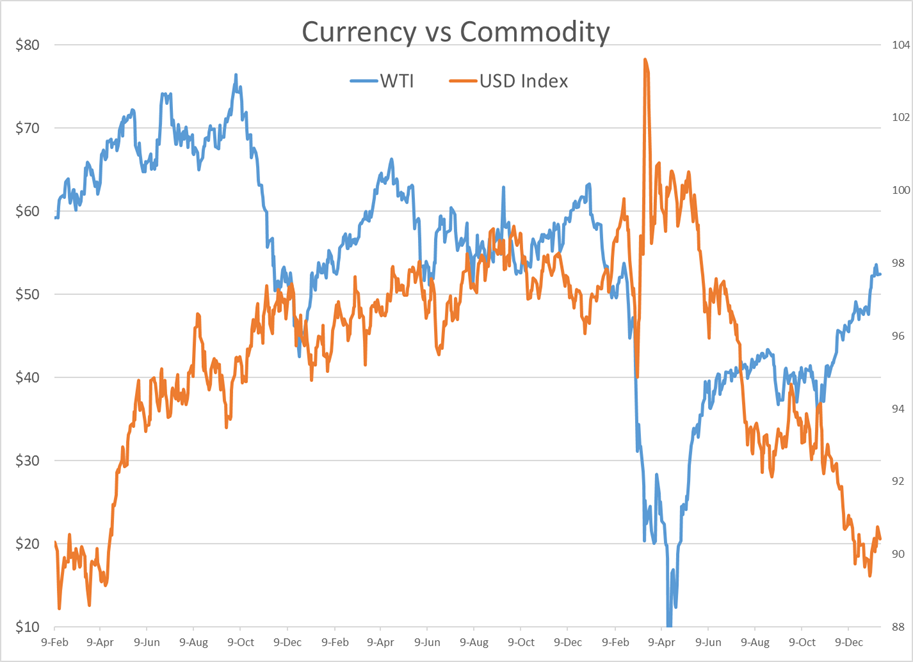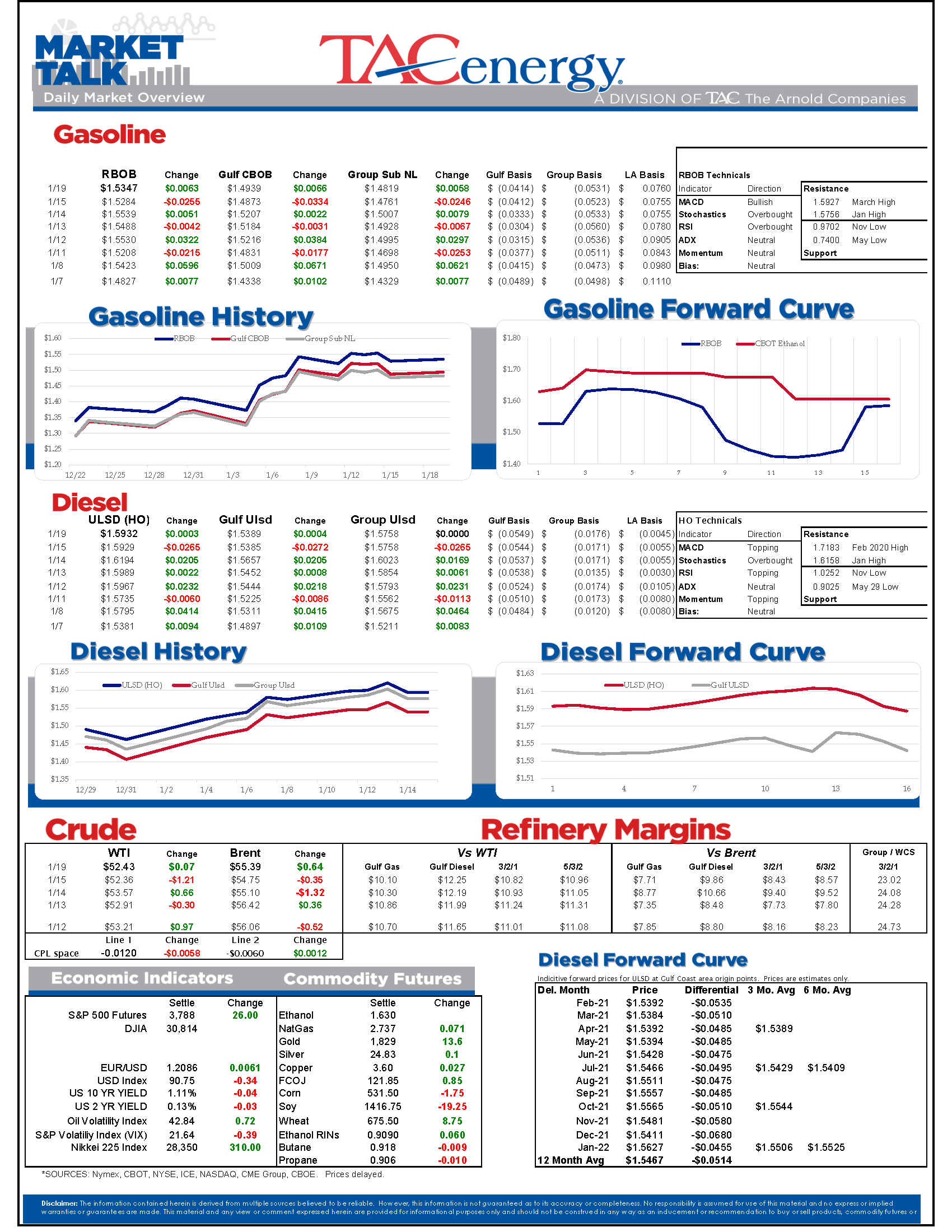Markets Hold Their Breath Ahead Of U.S. Presidential Inauguration

Energy markets have gained back the modest losses we saw in Monday’s abbreviated trading session, and are trading close to flat from Friday’s close. The upward sloping trendlines remain in place, but the bulls have some work to do to regain the momentum after the rally stalled last week.
U.S. equity markets are pointing higher, and the U.S. dollar is pointing lower, both of which may be contributing to the small bounce in energy futures to start the day as the markets seem to be holding their breath ahead of tomorrow’s U.S. presidential inauguration.
Pipelines look like they might be one of the first battlegrounds for the new administration with the Keystone XL developer offering a plan to make the pipeline “Carbon Neutral” in an effort to stop the incoming President from pulling the permit for the project on day 1 as reports suggest he is planning to do. The Keystone XL pipeline has been a political football for more than a decade at this point, but it’s the threat to Enbridge’s Line 5 traversing Michigan that could have more impact if it’s forced to close since it is currently in operation, with Marathon’s Detroit refinery likely to feel the most impact as nearly 1/3 of its crude comes from that line.
There’s a general expectation that an “ambitious” climate-related plan will be rolled out, but few details have yet been revealed, leaving the talking heads to debate whether the plan could be a great victory for the environment, or the end of the American Dream. Those hoping for moderation will find solace that despite one party controlling the legislative and executive branches, support from both parties is still likely to be needed for new laws to make it through the Senate.
Several reports in recent days have noted that California politicians are taking key roles in the new cabinet (in addition to the VP, who will have tie-breaking capabilities in the Senate). It’s possible that this could end up leading to federal programs that resemble the Golden State’s alphabet soup of environmental policies that put multiple different taxes and fees on fuel sales in order to limit certain fuel sales and fund new “clean[er] energy” projects.
The IEA’s monthly oil market report revised global demand estimates lower for the year due to the resurgence in COVID cases, and accompanying lockdowns. The report did offer some optimism for rapid improvement in the back half of the year as vaccine efforts and stimulus packages should both contribute to increased consumption, but that expected growth is not large enough to offset the drop in demand expected in Q1. The report did not offer a lot of optimism for refiners near term, noting that despite the cold snap that’s caused a spike in heating demand in Europe and Asia, refinery margins haven’t improved much as more plants coming out of turnaround were able to offset the increase in distillate demand.
Click here to download a PDF of today's TACenergy Market Talk.
Latest Posts
Gasoline Futures Are Leading The Way Lower This Morning
The Sell-Off Continues In Energy Markets, RBOB Gasoline Futures Are Now Down Nearly 13 Cents In The Past Two Days
Week 15 - US DOE Inventory Recap
Prices To Lease Space On Colonial’s Main Gasoline Line Continue To Rally This Week
Social Media
News & Views
View All
Gasoline Futures Are Leading The Way Lower This Morning
It was a volatile night for markets around the world as Israel reportedly launched a direct strike against Iran. Many global markets, from equities to currencies to commodities saw big swings as traders initially braced for the worst, then reversed course rapidly once Iran indicated that it was not planning to retaliate. Refined products spiked following the initial reports, with ULSD futures up 11 cents and RBOB up 7 at their highest, only to reverse to losses this morning. Equities saw similar moves in reverse overnight as a flight to safety trade soon gave way to a sigh of relief recovery.
Gasoline futures are leading the way lower this morning, adding to the argument that we may have seen the spring peak in prices a week ago, unless some actual disruption pops up in the coming weeks. The longer term up-trend is still intact and sets a near-term target to the downside roughly 9 cents below current values. ULSD meanwhile is just a nickel away from setting new lows for the year, which would open up a technical trap door for prices to slide another 30 cents as we move towards summer.
A Reuters report this morning suggests that the EPA is ready to announce another temporary waiver of smog-prevention rules that will allow E15 sales this summer as political winds continue to prove stronger than any legitimate environmental agenda. RIN prices had stabilized around 45 cents/RIN for D4 and D6 credits this week and are already trading a penny lower following this report.
Delek’s Big Spring refinery reported maintenance on an FCC unit that would require 3 days of work. That facility, along with several others across TX, have had numerous issues ever since the deep freeze events in 2021 and 2024 did widespread damage. Meanwhile, overnight storms across the Midwest caused at least one terminal to be knocked offline in the St. Louis area, but so far no refinery upsets have been reported.
Meanwhile, in Russia: Refiners are apparently installing anti-drone nets to protect their facilities since apparently their sling shots stopped working.
Click here to download a PDF of today's TACenergy Market Talk.

The Sell-Off Continues In Energy Markets, RBOB Gasoline Futures Are Now Down Nearly 13 Cents In The Past Two Days
The sell-off continues in energy markets. RBOB gasoline futures are now down nearly 13 cents in the past two days, and have fallen 16 cents from a week ago, leading to questions about whether or not we’ve seen the seasonal peak in gasoline prices. ULSD futures are also coming under heavy selling pressure, dropping 15 cents so far this week and are trading at their lowest level since January 3rd.
The drop on the weekly chart certainly takes away the upside momentum for gasoline that still favored a run at the $3 mark just a few days ago, but the longer term up-trend that helped propel a 90-cent increase since mid-December is still intact as long as prices stay above the $2.60 mark for the next week. If diesel prices break below $2.50 there’s a strong possibility that we see another 30 cent price drop in the next couple of weeks.
An unwind of long positions after Iran’s attack on Israel was swatted out of the sky without further escalation (so far anyway) and reports that Russia is resuming refinery runs, both seeming to be contributing factors to the sharp pullback in prices.
Along with the uncertainty about where the next attacks may or may not occur, and if they will have any meaningful impact on supply, come no shortage of rumors about potential SPR releases or how OPEC might respond to the crisis. The only thing that’s certain at this point, is that there’s much more spare capacity for both oil production and refining now than there was 2 years ago, which seems to be helping keep a lid on prices despite so much tension.
In addition, for those that remember the chaos in oil markets 50 years ago sparked by similar events in and around Israel, read this note from the NY Times on why things are different this time around.
The DOE’s weekly status report was largely ignored in the midst of the big sell-off Wednesday, with few noteworthy items in the report.
Diesel demand did see a strong recovery from last week’s throwaway figure that proves the vulnerability of the weekly estimates, particularly the week after a holiday, but that did nothing to slow the sell-off in ULSD futures.
Perhaps the biggest next of the week was that the agency made its seasonal changes to nameplate refining capacity as facilities emerged from their spring maintenance.
PADD 2 saw an increase of 36mb/day, and PADD 3 increased by 72mb/day, both of which set new records for regional capacity. PADD 5 meanwhile continued its slow-motion decline, losing another 30mb/day of capacity as California’s war of attrition against the industry continues. It’s worth noting that given the glacial pace of EIA reporting on the topic, we’re unlikely to see the impact of Rodeo’s conversion in the official numbers until next year.
Speaking of which, if you believe the PADD 5 diesel chart below that suggests the region is running out of the fuel, when in fact there’s an excess in most local markets, you haven’t been paying attention. Gasoline inventories on the West Coast however do appear consistent with reality as less refining output and a lack of resupply options both continue to create headaches for suppliers.



